Abdul Rehman
Explainable AI for Curie Temperature Prediction in Magnetic Materials
Aug 09, 2025Abstract:We explore machine learning techniques for predicting Curie temperatures of magnetic materials using the NEMAD database. By augmenting the dataset with composition-based and domain-aware descriptors, we evaluate the performance of several machine learning models. We find that the Extra Trees Regressor delivers the best performance reaching an R^2 score of up to 0.85 $\pm$ 0.01 (cross-validated) for a balanced dataset. We employ the k-means clustering algorithm to gain insights into the performance of chemically distinct material groups. Furthermore, we perform the SHAP analysis to identify key physicochemical drivers of Curie behavior, such as average atomic number and magnetic moment. By employing explainable AI techniques, this analysis offers insights into the model's predictive behavior, thereby advancing scientific interpretability.
Advances in LLMs with Focus on Reasoning, Adaptability, Efficiency and Ethics
Jun 14, 2025Abstract:This survey paper outlines the key developments in the field of Large Language Models (LLMs), such as enhancing their reasoning skills, adaptability to various tasks, increased computational efficiency, and ability to make ethical decisions. The techniques that have been most effective in bridging the gap between human and machine communications include the Chain-of-Thought prompting, Instruction Tuning, and Reinforcement Learning from Human Feedback. The improvements in multimodal learning and few-shot or zero-shot techniques have further empowered LLMs to handle complex jobs with minor input. They also manage to do more with less by applying scaling and optimization tricks for computing power conservation. This survey also offers a broader perspective on recent advancements in LLMs going beyond isolated aspects such as model architecture or ethical concerns. It categorizes emerging methods that enhance LLM reasoning, efficiency, and ethical alignment. It also identifies underexplored areas such as interpretability, cross-modal integration and sustainability. With recent progress, challenges like huge computational costs, biases, and ethical risks remain constant. Addressing these requires bias mitigation, transparent decision-making, and clear ethical guidelines. Future research will focus on enhancing models ability to handle multiple input, thereby making them more intelligent, safe, and reliable.
Leveraging Sparse Annotations for Leukemia Diagnosis on the Large Leukemia Dataset
Apr 03, 2025Abstract:Leukemia is 10th most frequently diagnosed cancer and one of the leading causes of cancer related deaths worldwide. Realistic analysis of Leukemia requires White Blook Cells (WBC) localization, classification, and morphological assessment. Despite deep learning advances in medical imaging, leukemia analysis lacks a large, diverse multi-task dataset, while existing small datasets lack domain diversity, limiting real world applicability. To overcome dataset challenges, we present a large scale WBC dataset named Large Leukemia Dataset (LLD) and novel methods for detecting WBC with their attributes. Our contribution here is threefold. First, we present a large-scale Leukemia dataset collected through Peripheral Blood Films (PBF) from several patients, through multiple microscopes, multi cameras, and multi magnification. To enhance diagnosis explainability and medical expert acceptance, each leukemia cell is annotated at 100x with 7 morphological attributes, ranging from Cell Size to Nuclear Shape. Secondly, we propose a multi task model that not only detects WBCs but also predicts their attributes, providing an interpretable and clinically meaningful solution. Third, we propose a method for WBC detection with attribute analysis using sparse annotations. This approach reduces the annotation burden on hematologists, requiring them to mark only a small area within the field of view. Our method enables the model to leverage the entire field of view rather than just the annotated regions, enhancing learning efficiency and diagnostic accuracy. From diagnosis explainability to overcoming domain shift challenges, presented datasets could be used for many challenging aspects of microscopic image analysis. The datasets, code, and demo are available at: https://im.itu.edu.pk/sparse-leukemiaattri/
Deep neural network-based detection of counterfeit products from smartphone images
Oct 08, 2024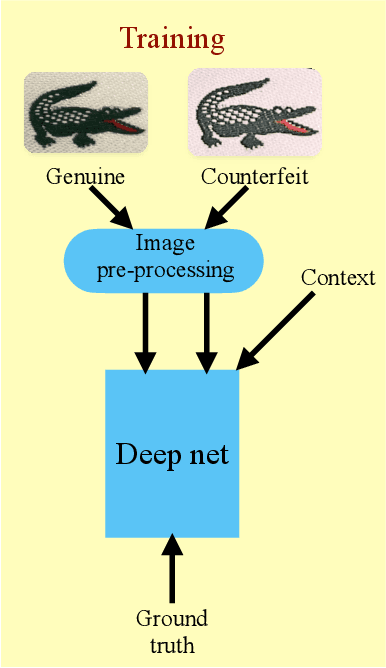
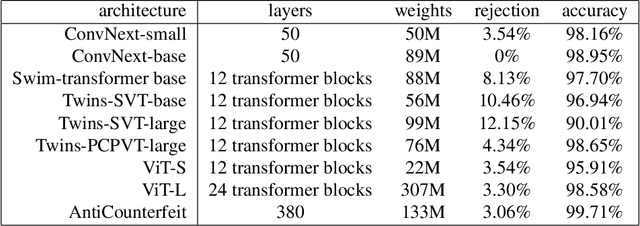
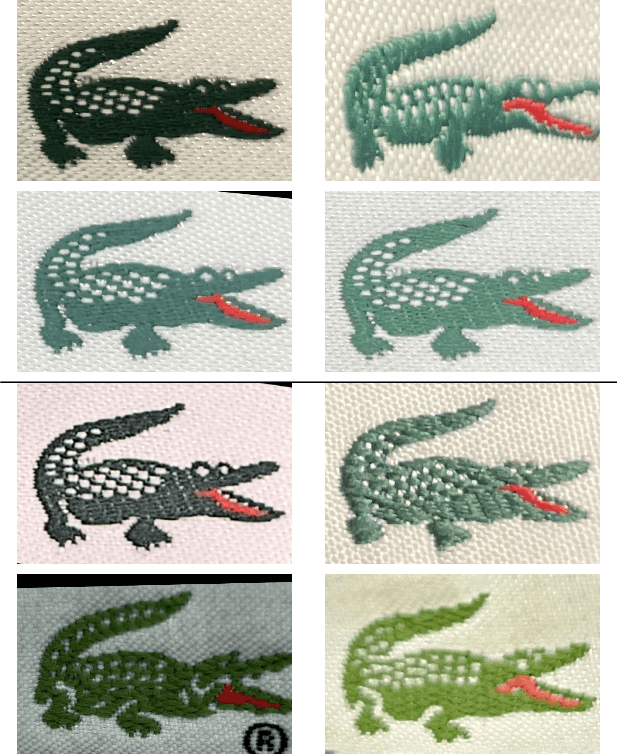
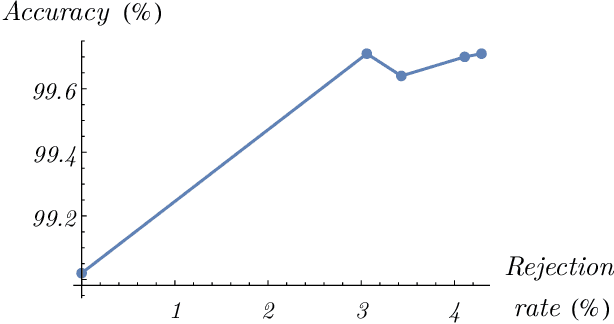
Abstract:Counterfeit products such as drugs and vaccines as well as luxury items such as high-fashion handbags, watches, jewelry, garments, and cosmetics, represent significant direct losses of revenue to legitimate manufacturers and vendors, as well as indirect costs to societies at large. We present the world's first purely computer-vision-based system to combat such counterfeiting-one that does not require special security tags or other alterations to the products or modifications to supply chain tracking. Our deep neural network system shows high accuracy on branded garments from our first manufacturer tested (99.71% after 3.06% rejections) using images captured under natural, weakly controlled conditions, such as in retail stores, customs checkpoints, warehouses, and outdoors. Our system, suitably transfer trained on a small number of fake and genuine articles, should find application in additional product categories as well, for example fashion accessories, perfume boxes, medicines, and more.
Preserving Empirical Probabilities in BERT for Small-sample Clinical Entity Recognition
Sep 05, 2024



Abstract:Named Entity Recognition (NER) encounters the challenge of unbalanced labels, where certain entity types are overrepresented while others are underrepresented in real-world datasets. This imbalance can lead to biased models that perform poorly on minority entity classes, impeding accurate and equitable entity recognition. This paper explores the effects of unbalanced entity labels of the BERT-based pre-trained model. We analyze the different mechanisms of loss calculation and loss propagation for the task of token classification on randomized datasets. Then we propose ways to improve the token classification for the highly imbalanced task of clinical entity recognition.
Joint Stream: Malignant Region Learning for Breast Cancer Diagnosis
Jun 26, 2024



Abstract:Early diagnosis of breast cancer (BC) significantly contributes to reducing the mortality rate worldwide. The detection of different factors and biomarkers such as Estrogen receptor (ER), Progesterone receptor (PR), Human epidermal growth factor receptor 2 (HER2) gene, Histological grade (HG), Auxiliary lymph node (ALN) status, and Molecular subtype (MS) can play a significant role in improved BC diagnosis. However, the existing methods predict only a single factor which makes them less suitable to use in diagnosis and designing a strategy for treatment. In this paper, we propose to classify the six essential indicating factors (ER, PR, HER2, ALN, HG, MS) for early BC diagnosis using H\&E stained WSI's. To precisely capture local neighboring relationships, we use spatial and frequency domain information from the large patch size of WSI's malignant regions. Furthermore, to cater the variable number of regions of interest sizes and give due attention to each region, we propose a malignant region learning attention network. Our experimental results demonstrate that combining spatial and frequency information using the malignant region learning module significantly improves multi-factor and single-factor classification performance on publicly available datasets.
A Large-scale Multi Domain Leukemia Dataset for the White Blood Cells Detection with Morphological Attributes for Explainability
May 17, 2024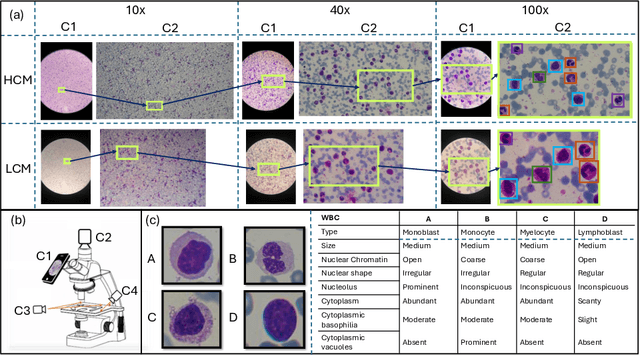
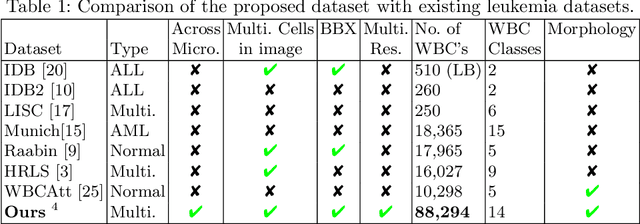
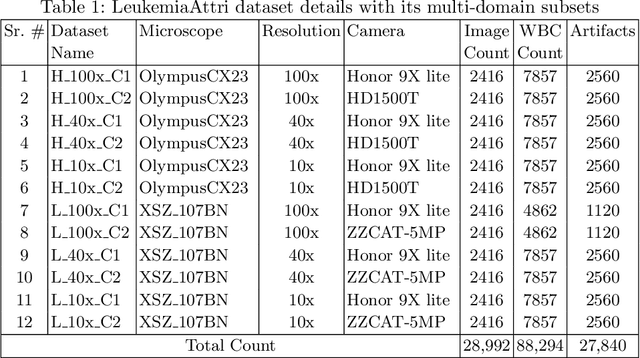
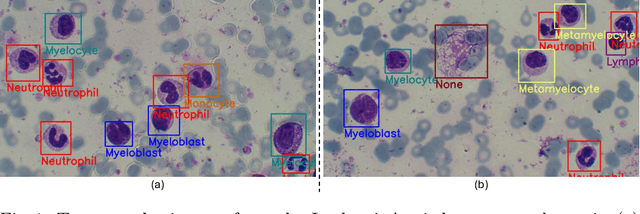
Abstract:Earlier diagnosis of Leukemia can save thousands of lives annually. The prognosis of leukemia is challenging without the morphological information of White Blood Cells (WBC) and relies on the accessibility of expensive microscopes and the availability of hematologists to analyze Peripheral Blood Samples (PBS). Deep Learning based methods can be employed to assist hematologists. However, these algorithms require a large amount of labeled data, which is not readily available. To overcome this limitation, we have acquired a realistic, generalized, and large dataset. To collect this comprehensive dataset for real-world applications, two microscopes from two different cost spectrums (high-cost HCM and low-cost LCM) are used for dataset capturing at three magnifications (100x, 40x, 10x) through different sensors (high-end camera for HCM, middle-level camera for LCM and mobile-phone camera for both). The high-sensor camera is 47 times more expensive than the middle-level camera and HCM is 17 times more expensive than LCM. In this collection, using HCM at high resolution (100x), experienced hematologists annotated 10.3k WBC types (14) and artifacts, having 55k morphological labels (Cell Size, Nuclear Chromatin, Nuclear Shape, etc.) from 2.4k images of several PBS leukemia patients. Later on, these annotations are transferred to other 2 magnifications of HCM, and 3 magnifications of LCM, and on each camera captured images. Along with the LeukemiaAttri dataset, we provide baselines over multiple object detectors and Unsupervised Domain Adaptation (UDA) strategies, along with morphological information-based attribute prediction. The dataset will be publicly available after publication to facilitate the research in this direction.
DROID: A Large-Scale In-The-Wild Robot Manipulation Dataset
Mar 19, 2024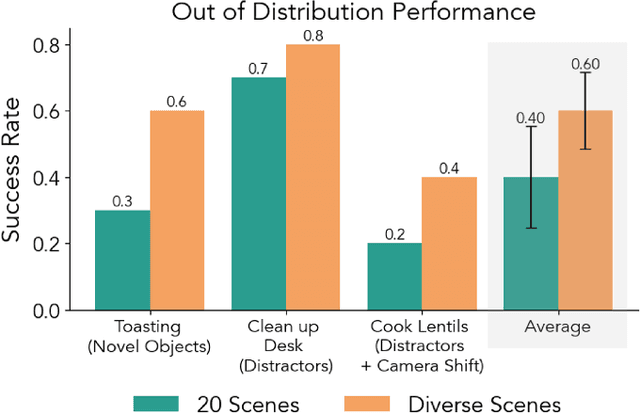
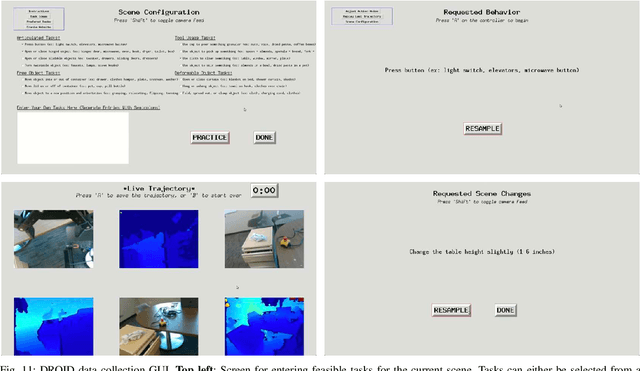
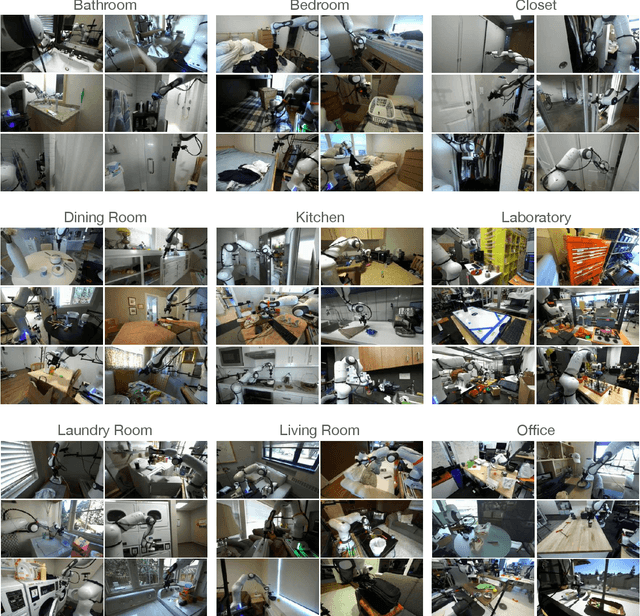
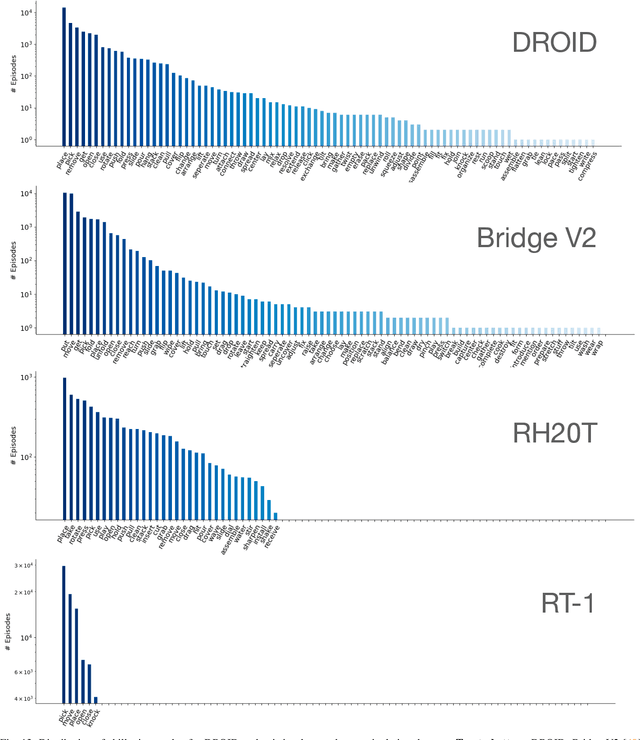
Abstract:The creation of large, diverse, high-quality robot manipulation datasets is an important stepping stone on the path toward more capable and robust robotic manipulation policies. However, creating such datasets is challenging: collecting robot manipulation data in diverse environments poses logistical and safety challenges and requires substantial investments in hardware and human labour. As a result, even the most general robot manipulation policies today are mostly trained on data collected in a small number of environments with limited scene and task diversity. In this work, we introduce DROID (Distributed Robot Interaction Dataset), a diverse robot manipulation dataset with 76k demonstration trajectories or 350 hours of interaction data, collected across 564 scenes and 84 tasks by 50 data collectors in North America, Asia, and Europe over the course of 12 months. We demonstrate that training with DROID leads to policies with higher performance and improved generalization ability. We open source the full dataset, policy learning code, and a detailed guide for reproducing our robot hardware setup.
A survey of the Vision Transformers and its CNN-Transformer based Variants
May 25, 2023Abstract:Vision transformers have recently become popular as a possible alternative to convolutional neural networks (CNNs) for a variety of computer vision applications. These vision transformers due to their ability to focus on global relationships in images have large capacity, but may result in poor generalization as compared to CNNs. Very recently, the hybridization of convolution and self-attention mechanisms in vision transformers is gaining popularity due to their ability of exploiting both local and global image representations. These CNN-Transformer architectures also known as hybrid vision transformers have shown remarkable results for vision applications. Recently, due to the rapidly growing number of these hybrid vision transformers, there is a need for a taxonomy and explanation of these architectures. This survey presents a taxonomy of the recent vision transformer architectures, and more specifically that of the hybrid vision transformers. Additionally, the key features of each architecture such as the attention mechanisms, positional embeddings, multi-scale processing, and convolution are also discussed. This survey highlights the potential of hybrid vision transformers to achieve outstanding performance on a variety of computer vision tasks. Moreover, it also points towards the future directions of this rapidly evolving field.
Classifying Text-Based Conspiracy Tweets related to COVID-19 using Contextualized Word Embeddings
Mar 07, 2023Abstract:The FakeNews task in MediaEval 2022 investigates the challenge of finding accurate and high-performance models for the classification of conspiracy tweets related to COVID-19. In this paper, we used BERT, ELMO, and their combination for feature extraction and RandomForest as classifier. The results show that ELMO performs slightly better than BERT, however their combination at feature level reduces the performance.
* Published in Multimedia Benchmark Workshop 2022, Bergen, Norway and Online, 12-13 January 2023: https://2022.multimediaeval.com/
 Add to Chrome
Add to Chrome Add to Firefox
Add to Firefox Add to Edge
Add to Edge